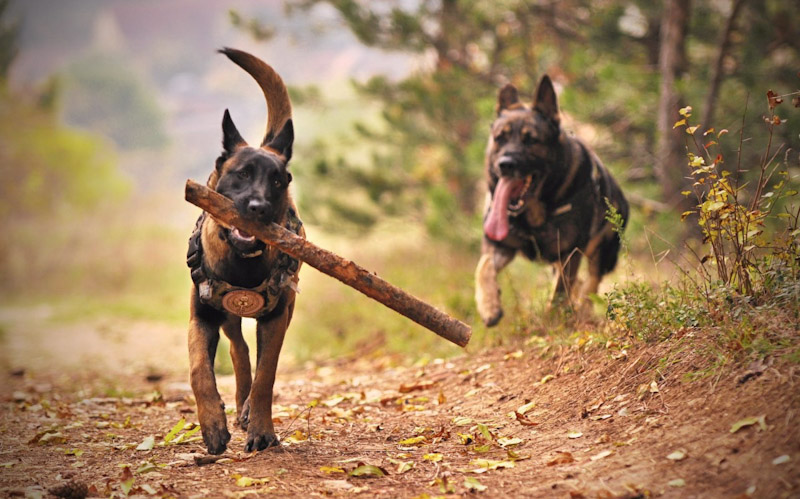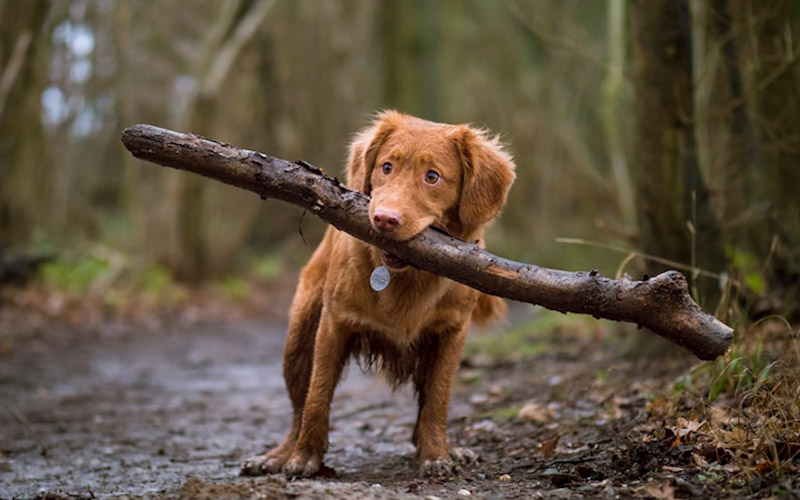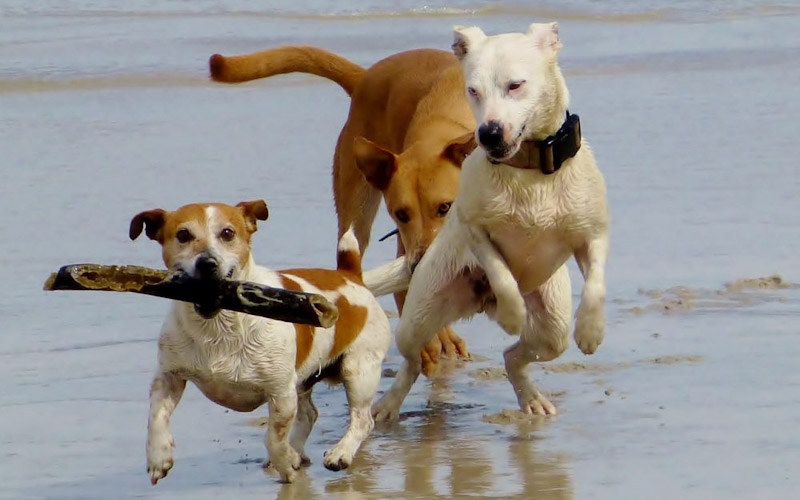Ever wonder why your dog goes crazy for sticks? Dive into the fascinating science behind this canine obsession, exploring instincts, senses, and more!

Imagine this scenario: you are walking your dog in the park, enjoying the fresh air and the scenery. Suddenly, your dog spots a stick on the ground and runs towards it with excitement. He picks it up with his mouth and starts to chew on it, wagging his tail and making happy noises. He looks at you with a proud expression, as if he just found the most precious treasure in the world.
You might wonder: why does your dog love sticks so much? What is it about these simple objects that makes them so appealing to your furry friend? Is it just a fun game, or is there something deeper behind this behavior?
In this article, we will explore the scientific reasons behind why dogs love sticks, covering topics such as:
- Instinctual behavior: how dogs are descended from wolves and retain some hunting instincts, using sticks as practice tools for retrieving prey.
- Sensory stimulation: how sticks engage multiple senses: smell, taste, texture, sound (when chewed).
- Physical and mental exercise: how chewing and carrying sticks provide physical activity and mental stimulation, reducing boredom and destructive behaviors.
- Social interaction: how sticks can be used for playful interactions with other dogs, strengthening social bonds.
We will also mention some additional information, such as:
- Different types of sticks preferred by dogs and the reasons behind them.
- Potential safety concerns with sticks (e.g., splintering, ingesting).
- Fun facts about dogs and sticks.
Are you ready to learn more about why dogs love sticks? Let’s get started!
Instinctual Behavior
One of the main reasons why dogs love sticks is because they are instinctually driven to do so. Dogs are descended from wolves, and even though they have been domesticated for thousands of years, they still retain some of their ancestral traits and behaviors.

One of these behaviors is hunting. Wolves are natural predators, and they use their teeth and jaws to catch and kill their prey. They also use their mouths to carry their prey back to their den, where they can share it with their pack members.
Dogs have inherited these hunting instincts from their wolf ancestors, and they use sticks as a substitute for prey. Sticks resemble the shape and size of small animals, such as rabbits or squirrels, and they trigger the dog’s predatory drive. When a dog sees a stick, he instinctively wants to chase it, catch it, and bring it back to his owner, who is his pack leader.
Sticks also provide a way for dogs to practice their hunting skills, such as stalking, pouncing, biting, and shaking. These skills are essential for survival in the wild, and even though dogs do not need to hunt for food anymore, they still enjoy exercising them for fun and stimulation.
Sensory Stimulation
Another reason why dogs love sticks is because they provide sensory stimulation. Sticks engage multiple senses, such as smell, taste, texture, and sound, and dogs love to explore them with their mouths.
Smell: Sticks have a natural scent that dogs find appealing. They can smell the wood, the bark, the sap, and even the traces of other animals that have touched the stick. Dogs have a very powerful sense of smell, and they use it to gather information about their environment and communicate with other dogs. Sticks offer a variety of smells that dogs can sniff and analyze, satisfying their curiosity and interest.
Taste: Sticks also have a natural taste that dogs enjoy. They can taste the wood, the bark, the sap, and even the dirt or grass that the stick has been in contact with. Dogs have fewer taste buds than humans, but they still have preferences for certain flavors and textures. Sticks offer a range of tastes that dogs can savor and chew on, satisfying their appetite and desire.
Texture: Sticks also have a natural texture that dogs like. They can feel the wood, the bark, the sap, and even the splinters or knots that the stick has. Dogs have a very sensitive sense of touch, and they use it to explore and manipulate objects with their mouths. Sticks offer a variety of textures that dogs can feel and gnaw on, satisfying their need and pleasure.
Sound: Sticks also have a natural sound that dogs love. They can hear the wood, the bark, the sap, and even the cracking or snapping that the stick makes when they chew on it. Dogs have a very acute sense of hearing, and they use it to detect and locate sounds in their environment. Sticks offer a variety of sounds that dogs can hear and create, satisfying their alertness and excitement.
Physical and Mental Exercise
A third reason why dogs love sticks is because they provide physical and mental exercise. Chewing and carrying sticks require physical activity and mental stimulation, which are both essential for a dog’s health and well-being.

Physical activity: Chewing and carrying sticks involve the use of the dog’s muscles, bones, joints, and teeth. These parts of the body need regular exercise to stay strong and healthy, and to prevent problems such as obesity, arthritis, or dental issues. Sticks offer a natural and fun way for dogs to exercise these parts of their body, satisfying their physical needs and energy.
Mental stimulation: Chewing and carrying sticks also involve the use of the dog’s brain, senses, and emotions. These parts of the body need regular stimulation to stay sharp and happy, and to prevent problems such as boredom, anxiety, or depression. Sticks offer a natural and fun way for dogs to stimulate these parts of their body, satisfying their mental needs and mood.
Social Interaction
A fourth reason why dogs love sticks is because they provide social interaction. Sticks can be used for playful interactions with other dogs, strengthening social bonds and communication.
Dogs are social animals, and they need to interact with other dogs to learn and practice their social skills, such as body language, vocalization, and etiquette. These skills are important for a dog’s social development and harmony, and to prevent problems such as aggression, isolation, or fear.
Sticks can be used as toys or props for social games, such as fetch, tug-of-war, or keep-away. These games allow dogs to have fun and cooperate with each other, as well as to express their personality and emotions. Sticks can also be used as signals or messages for social communication, such as marking territory, showing interest, or inviting play. Sticks offer a natural and fun way for dogs to interact with other dogs, satisfying their social needs and relationships.
Additional Information
Besides the scientific reasons, there are some additional information that you might want to know about dogs and sticks, such as:
- Different types of sticks preferred by dogs and the reasons behind them. Some dogs prefer thin and long sticks, while others prefer thick and short sticks. Some dogs prefer fresh and green sticks, while others prefer dry and brown sticks. Some dogs prefer smooth and clean sticks, while others prefer rough and dirty sticks. The preferences depend on the dog’s breed, size, age, personality, and mood, as well as the availability and quality of the sticks.
- Potential safety concerns with sticks (e.g., splintering, ingesting). While sticks are generally safe and beneficial for dogs, there are some risks and hazards that you should be aware of and avoid. Some sticks can splinter or break into sharp pieces, which can injure the dog’s mouth, throat, or stomach. Some sticks can also contain harmful substances, such as pesticides, fungi, or bacteria, which can cause infections or poisoning. To prevent these problems, you should always supervise your dog when he plays with sticks, and choose sticks that are natural, clean, and sturdy.
- Fun facts about dogs and sticks. Here are some interesting and amusing facts about dogs and sticks that you might not know:
- The world record for the most sticks collected by a dog is held by a golden retriever named Finley, who can fit six sticks in his mouth at once.
- The world record for the longest stick carried by a dog is held by a border collie named Strudel, who carried a stick that was 2.8 meters long.
- The world record for the heaviest stick lifted by a dog is held by a mastiff named Hercules, who lifted a stick that weighed 11.8 kilograms.
- The world record for the fastest stick retrieval by a dog is held by a Labrador retriever named Jet, who fetched a stick that was thrown 100 meters away in 20.5 seconds.

Conclusion
In conclusion, dogs love sticks for many scientific reasons, such as:
- Instinctual behavior: sticks trigger their hunting drive and allow them to practice their hunting skills.
- Sensory stimulation: sticks engage their multiple senses: smell, taste, texture, and sound.
- Physical and mental exercise: sticks provide physical activity and mental stimulation, reducing boredom and destructive behaviors.
- Social interaction: sticks can be used for playful interactions with other dogs, strengthening social bonds and communication.
Sticks also offer some additional information, such as:
- Different types of sticks preferred by dogs and the reasons behind them.
- Potential safety concerns with sticks (e.g., splintering, ingesting).
- Fun facts about dogs and sticks.
By understanding why dogs love sticks, you can appreciate and enjoy this canine obsession more, and provide your dog with the best sticks possible. Sticks are not just simple objects, but natural and fun tools that enhance your dog’s life and happiness. Sticks are also a symbol of the special bond between humans and dogs, a bond that has lasted for millennia and will continue to do so.
